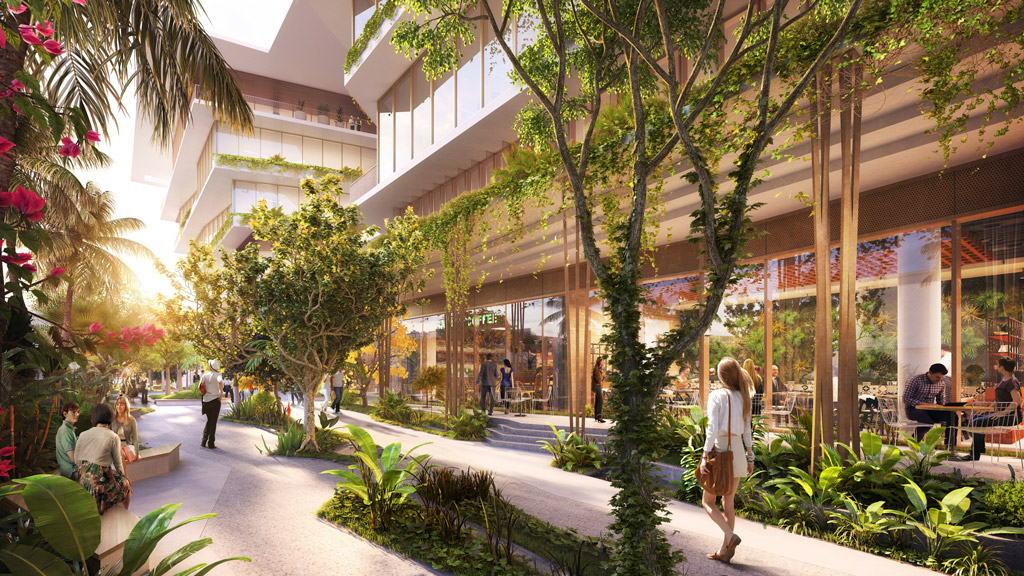An Architecture of Optimism for a Post-Pandemic Society
May 04, 2020 | By Jordan Goldstein
Editor’s Note: This post is part of our ongoing exploration of how design is responding to the COVID-19 pandemic.
One thing that’s clear from this pandemic is that there won’t be a flip of a switch that will suddenly fill malls, airports, office buildings, parks, and arenas with people. There will be a gradual re-engagement with our communities, and the architecture that defines those communities will be layered with a cautious optimism.
Whether it’s new buildings that are about to be designed or existing architecture that now needs to be re-imagined, in many ways this is a time for an architecture of optimism. Optimistic architecture isn’t architecture for the sake of architecture and doesn’t seek to glorify form. Rather, it’s an architecture that seeks to express its purpose in every aspect of the design – one that promotes wellness and celebrates life. It’s an architecture that makes people feel safe and can be trusted while still being inspirational. It’s design that supports the human experience at every scale and level of our daily lives.
To achieve this trust, we can design our environments to promote a healthier, safer way of being together, whether that’s in a workplace, a residential building, or public space.
Let’s start with the office building, since there’s so much attention on getting America back to work.
Imagine walking through the front vestibule of your office building where heat-sensing cameras scan your body temperature. It registers in the normal range and a green light flashes. The front doors open without a touch. As you walk towards the security kiosk, facial recognition technology recognizes that it’s you and knows, based on the calendar access you have granted, that you have a meeting today on the 15th floor, and signals an elevator. The elevator doors open and an LED light embedded in the elevator floor tells you where you should stand as it whisks you to your meeting. When you approach the 15th-floor meeting room, sensors cue the exterior glass walls to darken, the lights to dim, and the other attendees to appear virtually on the large screens that line the wall.
After the meeting, you head to your desk, again through elevators that recognize you and know what floor you sit on. Sensors in the ceiling know that it’s you. They set the desk to the correct height, adjust the lights, and turn on the heads-up display that is your work interface. Your virtual assistant greets you, reads through the morning messages and restructures the day around the urgent client matter that just came up. There’s no disruption to your coworker standing at their desk six feet away on the other side of a privacy screen, since the sound direction system above means you hear only what is coming from your digital interface.
And, with that, the workday is fully underway, all without you having touched a single surface.
Is this an architecture of a future age or the emerging recipe of design ingredients for a more immediate new normal? The good news is that the technology and building components needed to create this new normal already exist. The problem is that many have been implemented separate from one another instead of designed as one cohesive architectural solution. Current building products, sensor and AI technologies, and design strategies pulled together from different industries can bring us a new architecture type for a post-pandemic society that is safe and healthy while continuing to celebrate the human experience.
The challenge is that many strategies have been implemented separate from one another instead of designed as one cohesive architectural solution. That’s what needs to happen now.
We are seeing sparks of this innovation in several areas already.
In Beijing, we’re nearing completion on twin towers in the central business district that integrate facial recognition technology into the lobby security kiosks. Employees of the businesses in the building will be let through to elevators that will open without touching a surface.
In upcoming airport projects, the combination of the Internet of Things (IoT) and facial recognition will offer a more seamless and touch-free journey. The dirtiest part of the airport is the check-in kiosk so these will be retrofitted with biometric units and our face becomes our token. We will no longer need to exchange our documents and truly create a touch free environment. Many airports overseas already use digitally controlled temperature scanners for arriving international passengers, quickly identifying symptomatic travelers.
Manufacturers of flooring products are exploring LED lights embedded in surfaces like basketball courts to help coaches walk through plays in real-time. The LED lights let athletes know where to stand relative to one another for set plays. It’s not a stretch to consider integrating this technology into flooring in retail, restaurants and offices to provide visual cues where people should stand safely away from others.
Building facades can be designed to self-darken and to automatically circulate fresh air when the weather is good. For example, in a new building we’re designing outside of Washington DC, the glass skin will have integral technology that darkens the panels based on the path of the sun, eliminating the need for shades or blinds. PNC Tower in Pittsburgh, one of the greenest tall buildings in North America, is designed with a breathable double skin made of glass panels and embedded with sensors that will track optimal weather conditions and open the panels to allow fresh air inside.
It’s not hard to imagine all of these disparate technologies and systems coming together as part of a design strategy for a post-pandemic world.
Temperature sensors and facial recognition could detect a symptomatic worker in the building, triggering a series of physical changes. The heating and cooling system could immediately change to create a negative pressure environment in the zone where the illness was detected, preventing air that maybe contaminated from getting to another area of the building. Meanwhile, the glass panels on the building façade could instantly open to let fresh air into unaffected spaces. Those within the building continue their day, comforted by the fact that they’re safe where they are. The same technology can be used to regulate temperature and humidity to keep people comfortable under regular, illness-free conditions, improving energy efficiency and operating costs. What might be motivated initially for safety reasons could enhance wellness, not just avoid illness.
In Gensler’s New York office, one floor serves as an evolving “Living Lab.” We test the performance of the space through multiple sensor types that feed a real-time model of integrated data streams. That data informs design, utilization, and now social distancing and density considerations. To get the right results, engagement, and value out of buildings, we need to design technology solutions and space together to make them seamless to the human experience.
As all of us emerge from our homes and re-engage with our communities, the one thing we will be looking for is an underlying trust in the places and spaces into which we’re emerging. And, the hope that we can safely be together again will fuel an optimistic re-thinking of the built environment.
The time to define this architecture of optimism is now. The future of our cities depends on it.
For media inquiries, email .

